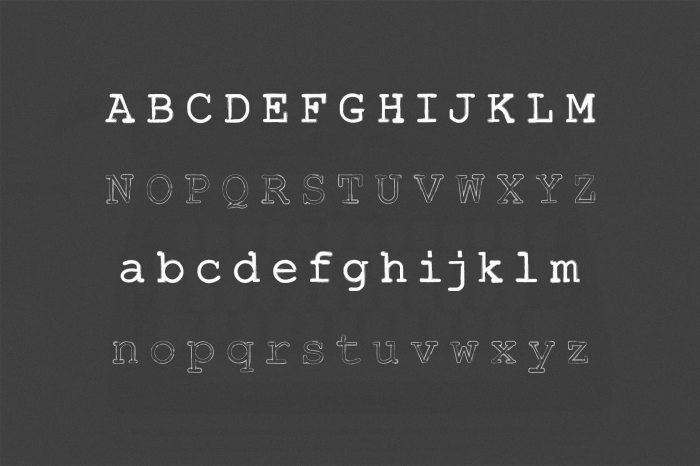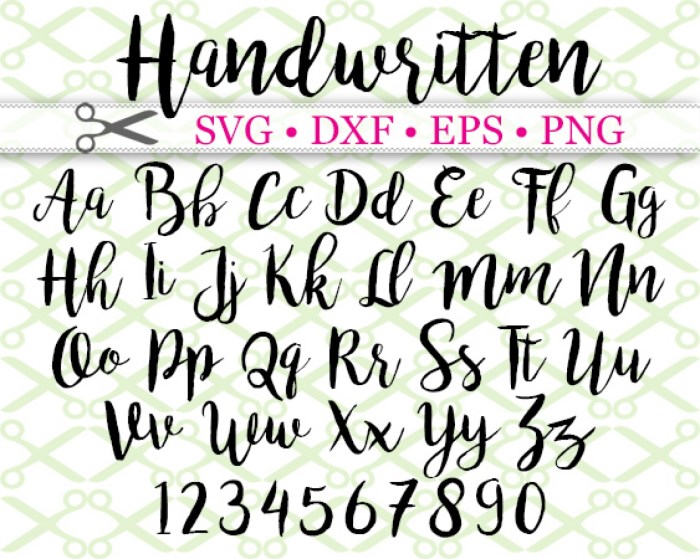A typeface with characteristics of handwriting – Typefaces with handwriting characteristics, a captivating blend of digital and analog aesthetics, have emerged as a powerful tool in the realm of typography. These typefaces mimic the nuances and expressiveness of human handwriting, offering designers a unique way to infuse their creations with a personal and organic touch.
Their origins can be traced back to the early days of printing, when type designers sought to replicate the beauty and authenticity of handwritten manuscripts. Over the centuries, these typefaces have evolved alongside technological advancements, adapting to the demands of digital design while retaining their timeless appeal.
Definition of a Typeface with Handwriting Characteristics

A typeface with handwriting characteristics emulates the appearance and flow of handwritten text. It typically exhibits the following distinguishing features:
- Irregular letterforms that vary in thickness and slant
- Connections between letters that mimic cursive writing
- Flourishes and embellishments that add a personal touch
Examples of typefaces with handwriting characteristics include Brush Script, Pacifico, and Lobster.
Historical Context and Evolution

The origins of typefaces with handwriting characteristics can be traced back to the early days of printing. Printers sought to create typefaces that resembled the handwritten manuscripts of the time. The development of lithography in the 19th century further facilitated the creation of typefaces that captured the nuances of handwriting.Calligraphy
and penmanship have had a profound influence on the design of typefaces with handwriting characteristics. The flowing strokes and graceful curves of calligraphy have inspired many type designers to create typefaces that convey a sense of elegance and sophistication.
Design Elements and Techniques: A Typeface With Characteristics Of Handwriting
To create the illusion of handwriting in typefaces, designers employ various design elements and techniques:
- Variable stroke width:Letters vary in thickness, creating the effect of pen pressure.
- Letterform irregularity:Letters are not perfectly symmetrical, giving them a more natural, handwritten appearance.
- Ligatures and swashes:Ligatures connect letters together, while swashes add decorative flourishes.
- Baseline variation:Letters are placed at slightly different heights, mimicking the variations in handwriting.
Legibility and Readability

The legibility and readability of typefaces with handwriting characteristics can vary depending on the specific design. Some typefaces may be more difficult to read at small sizes or in dense text, while others may be quite legible. Designers must carefully consider the intended use of a typeface when choosing one with handwriting characteristics.
Applications and Use Cases
Typefaces with handwriting characteristics are suitable for a wide range of applications, including:
- Invitations and greeting cards:They add a personal touch and convey a sense of warmth.
- Logos and branding:They create a unique and memorable identity.
- Headlines and titles:They draw attention and add visual interest.
- Social media posts:They create a more engaging and personal connection with followers.
Comparison with Traditional Handwriting

Typefaces with handwriting characteristics share similarities with traditional handwriting, but they also have distinct differences:
- Consistency:Typefaces are designed to be consistent in their appearance, while handwriting can vary greatly from person to person.
- Legibility:Typefaces are typically designed to be more legible than handwriting, especially at small sizes.
- Speed:Handwriting is typically slower to produce than typing, while typefaces can be reproduced quickly and efficiently.
Future Trends and Innovations
Emerging trends in the design of typefaces with handwriting characteristics include:
- Digital pen technology:The development of digital pens and tablets has made it easier to create typefaces that capture the nuances of handwriting.
- Artificial intelligence:AI algorithms can be used to analyze handwriting and create typefaces that mimic its unique characteristics.
- 3D printing:3D printing technology can be used to create physical objects that incorporate handwriting-like elements.
User Queries
What are the key characteristics of typefaces with handwriting characteristics?
These typefaces typically exhibit variations in stroke width, subtle curves, and organic shapes that mimic the natural flow of handwriting.
How do typefaces with handwriting characteristics compare to traditional handwriting?
While they share aesthetic similarities, digital typefaces offer greater consistency and precision than handwritten text, ensuring legibility and readability even at small sizes.
What are some effective applications for typefaces with handwriting characteristics?
These typefaces are well-suited for branding, packaging, invitations, personal correspondence, and any design that aims to convey a personal or handcrafted touch.